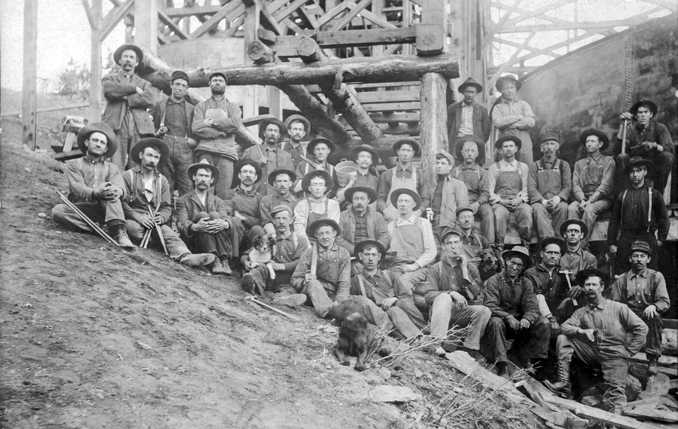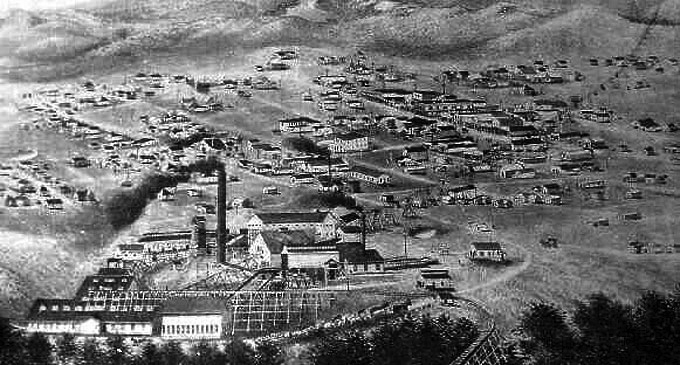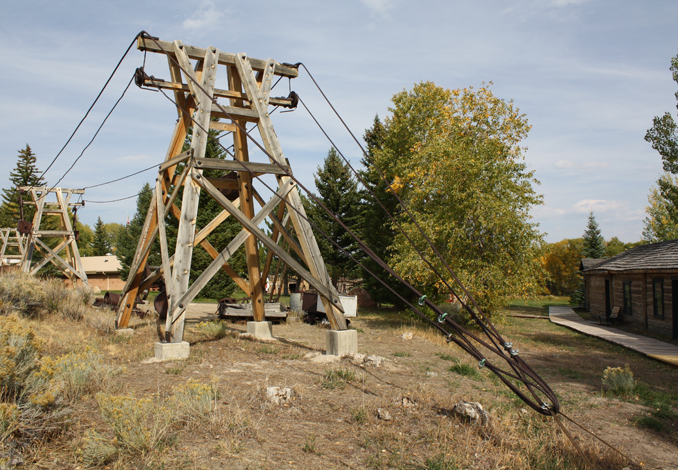- Home
- Encyclopedia
- Encampment, Wyoming: Copper, Lumber and Rendezvous
Encampment, Wyoming: Copper, Lumber and Rendezvous
Trappers and traders held rendezvous in the 1830s in a place they named Camp le Grand at the base of the Sierra Madre Mountains in what’s now south central Wyoming, and Ute and other tribes of American Indians were also in the area in those early days. A branch of the Cherokee Trail was blazed through the region by California-bound gold-seekers in the late 1840s.
The first white settlers arrived in the 1860s and 1870s. Tie hacks cut timber and floated the logs down creeks to the North Platte River during spring run-offs to supply ties for the Union Pacific Railroad. Ranchers brought cattle, with as many as 10,000 head reported in the area in the mid-1880s. The Cherokee Trail branch continued to be used in those years as well.

George Doane reportedly discovered copper in the mountains near Battle Lake in the Sierra Madres in the late 1880s and began the Doane-Rambler mine with his partners, but sheepherder Ed Haggarty’s copper vein find in 1897 marked the beginning of a decade-long boom—rich with monetary abundance, engineering achievement and skilled promoters—that some believed would cause the town of Grand Encampment to become a western industrial stronghold.
Grand Encampment was organized and incorporated with that name in 1897, but postal regulations required that the “Grand” be dropped. Willis George Emerson, a Chicago newspaperman, novelist and promoter, set up the town along with his associates, Bernard McCaffrey, Charles Freeman, Ed Heizer and Charles Clemmons. Emerson hired Chicagoan Grant Jones, another newspaperman, to help promote the area.
Haggarty formed the Rudefeha Mine with his boss George Ferris and partners Robert Deal and J. M. Rumsey, using the first two letters in each of their last names. Rumsey sold his share to Ferris for $1,000 and Deal backed out, and the mine became known as the Ferris-Haggarty. In 1899, Haggarty sold his interest to Ferris for $30,000.
The business thrived under Ferris’ ownership. He employed 250 men and used 400 horses to produce average daily shipments of 80,000 pounds of copper ore, which were shipped to Colorado. Unfortunately, Ferris was killed in a wagon accident the year he bought out Haggarty. Ferris’ wife, Julia, inherited his interest. In 1902, the North American Copper Company, with newspaperman and town founder Emerson as one of its stockholders, purchased the mine for $1 million.
The Boston & Wyoming Smelter, Power and Light Company began operations in Encampment in 1902. Emerson was instrumental in the creation of a 16-mile-long aerial tramway to transport ore from the mountains to the smelter. The tramway, the longest in the world at the time, was considered an engineering marvel and carried 840 buckets that held as much as 700 pounds of ore each.
In 1902, residents built the Grand Encampment Opera House to use as a meeting place. The next year, Charles E. Winter, an Encampment attorney who loved the area, wrote the lyrics to the song “Wyoming” while riding on a train in Pennsylvania. Earle Clemens, editor of the Grand Encampment Herald, set the words to music and the song was chosen as the state song in 1904 at the State Industrial Convention in Sheridan, Wyo., and played on Wyoming Day at the St. Louis World’s Fair.

The Saratoga & Encampment Railway reached Encampment from the main Union Pacific line to the north in August 1908, but the “Only Line to the Great Wyoming Copper Mining District” came too late. By that time, when the town’s population was reportedly 2,000 residents, copper prices had fallen from 20 cents per pound to 13 cents. A series of fires at the smelter caused setbacks there, and many people left. Property values fell. Wyoming historian T. A. Larson later explained that the boom was large enough to “somewhat damage” the state’s entire economy when things went bust.
Agriculture, mainly cattle and hay raising, sustained residents in the decades that followed. In 1917-1918, the flu epidemic struck, and local freighter “Gee-String” Jack Fulkerson hauled frozen bodies “stacked like cordwood” on wagons from the mountains, according to Moulton.
Tie hacks continued their work, but by the 1930s, truck hauling largely replaced the system of floating logs downstream. One tie hack, Lee Hammer, taught his trade to his son, Robert L. “Mike” Hammer. Mike purchased a portable sawmill in 1950 and used it in several areas in the county including Elk Mountain. Soon after the beginning of the next decade, he moved the sawmill to Encampment.
In 1952, meanwhile, the U.S. Air Force stationed men in Encampment. Their work included seismic monitoring in the Sierra Madres, but their mission was classified, so local citizens were not advised about why this testing was conducted. The Air Force’s motives would remain secret for 40 more years.
Encampment residents Vera Oldman and Hila Parkison discussed the need for a museum in 1963. They worked to prepare articles of incorporation and to assemble a board of directors. The board sent letters requesting funds, historical items and the community’s support. The response, according to Oldman’s first annual report for the Grand Encampment Museum in 1966 was “beyond our fondest dreams.” By that time, the Doc Culleton Memorial Building had been completed and plans were underway to create a file system and policies for housing artifacts.

Ranching, in the form of both working ranches and guest ranches, continues to be an important aspect of the area’s history. In 1986, former Standard Oil executive John E. Rouse donated his Angus cattle ranch, the One Bar Eleven, located near Encampment, to Colorado State University for a research facility to study and improve genetics in cattle raised at high elevations.
In the 1990s, the military declassified information regarding the 20-year period of Air Force activity in the Sierra Madres. The seismic analyses, made during the Cold War era, were used to map test explosions in Russia with the purpose of preventing possible nuclear attacks.
In 1998, Mike Hammer, who had operated his sawmill for several decades and had been joined in the enterprise by his sons David and Tom, retired. The Hammer Timber & Lumber Company, which had been a mainstay and at one time employed more people than any other Encampment business, closed. In 2009, for more than $629,800, the town of Encampment purchased the land where the mill stood. Currently, two businesses, Thompson Logging and Doggett Greenhouse, conduct their operations there. The property is now known as the Grand Encampment Business Park.
Rouse’s grandchildren purchased his 7,500-acre ranch in 2009 and leased it back to CSU, which established the John E. Rouse Chair in Animal Breeding and Genetics.
A $1 million Community Facilities grant awarded through the Wyoming Business Council and approved by the Wyoming Land and Investment Board, along with funds received from a variety of other donors, helped locals renovate the Grand Encampment Opera House. The work, completed in 2011, included enlargement of the stage and renovation of the bell tower as well as a kitchen addition. The Encampment Town Hall, which was located in the Opera House at one time, was moved to 614 McCaffrey Ave.
In 2011, Wyoming Travel and Tourism named the Grand Encampment Museum its “Attraction of the Year.” The facility now includes 14 buildings in addition to its famed two-story outhouse and Slash Ridge Fire Tower. As many as 7,000 visitors have toured the complex in a year, according to Judy Stepp, executive director of the GEM. Encampment’s population stands at about 450.
Annual activities, including the Sierra Madre Winter Carnival, Woodchoppers Jamboree, Grand Encampment Cowboy Gathering, Living History Day, Copper Days Festival and Chug-n-Tug Tractor Pull, continue to attract people to Encampment, hearkening back to the town’s heritage as a good place to rendezvous.
Resources
- Anderson, Nancy. Hanna Basin Museum Director. Telephone interview with author. Sept. 20, 2013.
- DeMarino, Nicholas. “Funds Secured, Encampment Plans for Opera House Renovations.” Rawlins Daily Times, March 1, 2010. Accessed May 20, 2013, at http://www.rawlinstimes.com.
- Dimas, Jennifer. “Can New Tools Help Identify Environmentally Fit Cattle for High Altitudes?” BEEF Magazine, April 2, 2012. Accessed Sept. 13, 2013, at http://www.beefmagazine.com/health/can-new-tools-help-identify-environmentally-fit-cattle-high-altitudes.
- Groenenberg, Wyoma. “Encampment Sawmill to Reopen.” April 1, 2011. Accessed May 29, 2013, at http://www.wyomingbusinessreport.com/article.asp?id=56935.
- Harvey, Doreen. Encampment Town Clerk. Telephone interviews with author. Sept. 10, 2013, and Sept. 12, 2013.
- “Here Comes the Railroad,” Grand Encampment Museum newsletter, Spring 2008, 1.
- Larson, T.A. History of Wyoming. 2nd ed., rev. Lincoln, Neb.: University of Nebraska Press, 1978, 334, 335.
- Moulton, Candy. The Grand Encampment: Settling the High Country. Glendo, Wyo.: High Plains Press, 1997, 37, 196, 197, 210, 211.
- _____________. Roadside History of Wyoming. Missoula, Mont.: Mountain Press Publishing, 1995, 8, 94, 265-269.
- Moulton, Candy and Terry A. Del Bene. Images of America: Grand Encampment. Charleston, S.C.: Arcadia Publishing, 2012, 60, 61, 66, 124.
- North Star Economics, Inc. “A Strategic Economic Development Plan for the Town of Saratoga, Wyoming.” Jan. 5, 2005. Accessed May 29, 2013, at http://www.northstareconomics.com/SaratogaPlan-FinalReport.pdf.
- Roybal, Joe. “Triple-Duty Hay Wedges.” BEEF Magazine, Sept. 1, 1999. Accessed Sept. 13, 2013, at http://www.beefmagazine.com/mag/beef_tripleduty_hay_wedges.
- Stepp, Judy. Executive Director, Grand Encampment Museum. Telephone interview with author, Sept. 11, 2013.
- Oldman, Vera. Grand Encampment Museum First Annual Report. Sept. 26, 1966. Grand Encampment Museum collections, Encampment, Wyo.
- United States Census 2010. “Demographic Profiles by County and Place.” Accessed Sept. 9, 2013, at http://eadiv.state.wy.us/demog_data/pop2010/Profile/2010Profiles_WY.html.
- Van Pelt, Lori. Dreamers and Schemers: Profiles from Carbon County’s Past. Glendo, Wyo.: High Plains Press, 1999, 197, 207-209, 217.
- Wyoming Places. “Encampment.” Accessed May 20, 2013, at http://wyld.sirsi.net/maps/index.html?q=Encampment.
Illustrations
- The photo of the Ferris-Haggarty copper miners is from the Wyoming State Archives. Used with permission and thanks.
- The 1903 photo of the tramway is from the S.H. Knight Collection at the American Heritage Center, University of Wyoming. Used with permission and thanks.
- The Houghton drawing of early Encampment is from Wyoming Tales and Trails. Used with thanks.
- The photo of the tram towers at the Grand Encampment Museum is by Tom Rea.
